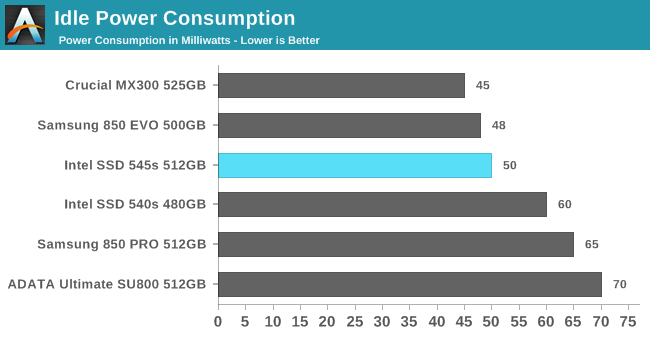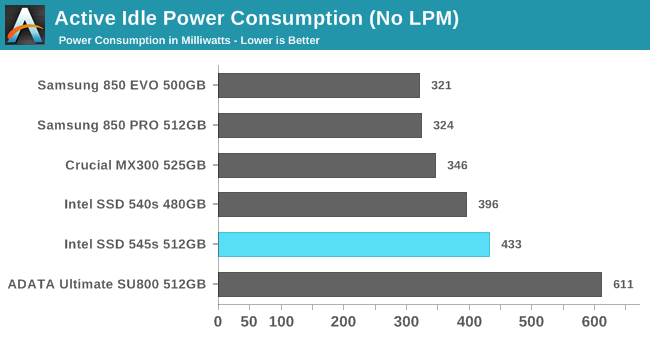The Intel SSD 545s (512GB) Review: 64-Layer 3D TLC NAND Hits Retail
by Billy Tallis on June 27, 2017 6:00 AM ESTIdle Power Consumption
Since the ATSB tests based on real-world usage cut idle times short to 25ms, their power consumption scores paint an inaccurate picture of the relative suitability of drives for mobile use. During real-world client use, a solid state drive will spend far more time idle than actively processing commands. Our SYSmark 2014 SE test covers this case, but because our testbed is a desktop system the SSD's contribution to the total power usage is small and hard to isolate from ordinary variation between test runs.
Our testbed doesn't support the deepest DevSlp power saving mode that SATA drives can implement, but we can measure the power usage in the intermediate slumber state where both the host and device ends of the SATA link enter a low-power state and the drive is free to engage its internal power savings measures.
We also report the drive's idle power consumption while the SATA link is active and not in any power saving state. Drives are required to be able to wake from the slumber state in under 10 milliseconds, but that still leaves plenty of room for them to add latency to a burst of I/O. Because of this, many desktops default to either not using SATA Aggressive Link Power Management (ALPM) at all or to only enable it partially without making use of the device-initiated power management (DIPM) capability. Additionally, SATA Hot-Swap is incompatible with the use of DIPM, so our SSD testbed usually has DIPM turned off during performance testing.

With SATA device-initiated link power management enabled, typical idle power consumption drops by a factor of ten, straining the resolution of our power meter. All of these SATA SSDs have very effective low-power idle states, but the 545s does show clear improvement over the 540s and Intel is now quite close to the Crucial MX300 and Samsung 850 EVO.

The Samsung drives have the best active idle power levels of this bunch, and the Crucial MX300 is not far behind. The Silicon Motion-based Intel 540s, 545s and ADATA SU800 are worst, though only the SU800 is trailing by a large margin. The 545s does draw more power than the 540s, which is not what we would expect from an updated controller design.
Idle Wake-Up Latency
Idle power consumption is not the only important metric of a SSD's power management capabilities. Devices cannot transition in and out of low-power states instantly. It takes time for components to switch back to higher clock speeds and resynchronize their data links to the rest of the system. At the extreme end, the several seconds it takes a hard drive to spin up obviously has a major impact on system responsiveness, and consequently operating systems have to be very conservative about when to put a hard drive to sleep, typically requiring at least several minutes of idle time during which the hard drive is wasting power.
The idle power transition time of solid state drives exists on a very different time scale, but it still matters to systems that are trying to minimize power consumption without sacrificing too much performance. When a SSD only takes a few milliseconds to enter and leave a power saving state, those power saving states can be used far more often, even during sustained interactive use like gaming. The cost of this approach is that far more I/O operations will incur the wake-up latency penalty.
Our equipment is not able to measure how long it takes a SSD to enter a low-power state; this would require very precise synchronization between the CPU and a high-resolution power meter. Timing how long a SSD takes to leave a low-power state is simple: perform one read operation every few seconds, and compare the latency with and without power management enabled. The difference, reported below, includes time taken to reestablish the SATA link and for the SSD to wake up, but does not include the time spent actively reading data from the flash memory since that will be the same whether or not the SSD had just been in a low-power state. Thus, this test is mostly a measure of the SSD controller and its firmware.

The Crucial MX300 has pretty good power consumption both at idle and under load, but its Marvell controller takes far longer to wake up from idle than its competition. At about 3.4ms, the MX300 is almost five times slower to wake up than the ADATA SU800, which has higher idle power consumption. The Intel 545s is a bit on the slow side at 1.4ms, about twice the wake-up latency of the ADATA SU800 or the Intel 540s. The total read latency for the 545s with power management enabled is just over 2.2ms.










74 Comments
View All Comments
ddriver - Tuesday, June 27, 2017 - link
Great, now if they could just make a decent NVME SSD as well.ddriver - Tuesday, June 27, 2017 - link
Shame it took them entire 3 years to catch up to the 850 pro. Lets hope they will match the 960 pro before 2020 LOL.eddieobscurant - Tuesday, June 27, 2017 - link
They caught up with the 850 evo, not the proATC9001 - Tuesday, June 27, 2017 - link
True...but atleast for the first time in I think...ever, there's a drive that can compete with the EVO...hopefully we can see the EVO drives start to drop a bit.Alexvrb - Tuesday, June 27, 2017 - link
It IS nice to see some serious competition for the Evo. The 850 Evo is still my go-to for upgrading older systems from a mechanical drive.Now all I need is some serious price drops for lower-performance higher-capacity TLC drives and I can ditch the mechanical drive for mass storage too. Price:capacity hasn't budged much in recent memory. :-/
Impulses - Tuesday, June 27, 2017 - link
Hasn't budged at all... I bought two 1TB EVOs two years ago, almost to the date (Newegg invoice is dated 7/15/2015 for the first one), paid $340 for one and a couple weeks or a month later I managed to get a second one for $320.I was hoping two years later I could buy a 2TB drive to add to those for the same kinda money, instead the prices are exactly the same right now. The recent shortage and price hike didn't help, up until that point I remember prices steadily declining for at least 4-5 years straight...
I guess that couldn't last, historically the flash market has been more volatile (no pun intended) than not, the kind of stability that went on for a couple years aligned with Samsung's rise to SSD dominance were kind of rare in the grand scheme.
At this rate it's gonna be another 3+ years before I can score a couple good 2TB drives for $300/ea, meh.
andychow - Tuesday, June 27, 2017 - link
Nand is in shortage, has been for a few years. In the past, manufacturers would ramp up production, there would eventually be a surplus, and prices would crash. This time around, they've all decided to basically to ride out the shortage by telling their clients to wait.Alexvrb - Wednesday, June 28, 2017 - link
That seems strange. If they have the ability to ramp and fill demand, you would think one of these outfits would be happy to fill that gap and steal those sales. I thought perhaps they are unable to ramp the flash which is in greatest demand. I hope things get better with future heavily-layered TLC/QLC and upgraded controllers. I would like nothing more than to ditch my secondary mechanical drive for flash, but there's no way I'm spending that kind of money.ddriver - Thursday, June 29, 2017 - link
There is nothing strange about it, they know if flash is in shortage they will make more on every grain of sand they put into it. It is like an implicit mutual agreement to sustain an artificial shortage to make more money. And everyone is happy.They still sell as much SSDs as they can, but at a higher price. SSDs are available, but the supply is deliberately held tight, so there is a perpetual "they might run out" even though supply exceeds demand, it is carefully kept short. Nobody is waiting on flash, no company is missing on sales, they still sell as much as they can, they simply take care not to exceed demand by too much, so they do less work to get extra profits. It is an immensely great deal for them.
There is no motivation for any of the big players to end this shortage, because that would drive prices down, hurt their own margins and those of everyone else, and give the others an excuse for hostile actions in retaliation, which they don't really want, because even though to us they are apparent competitors, they are all in it for the money, and they have estimated that cooperating to keep supply tight will win them more than competing who will make the most or the best SSDs.
It sounds like it is illegal, but considering it is all common sense and they didn't have to collude in some dark room to make an explicit agreement to do so, it is perfectly legal as far as the corrupt justice system is concerned.
Error415 - Tuesday, October 3, 2017 - link
Yeah, it should be illegal for a company to decide not drive prices down by flooding the market with cheap products, shm.What sounds illegal to you is a text book example of a sustainable business model. No booms or busts just steady growth and profit.